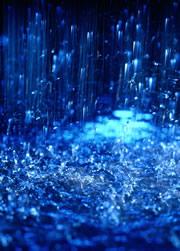 Climate models might have underestimated future changes in rainfall.Getty
Climate models might have underestimated future changes in rainfall.GettyHuman activity has made the weather wetter in a large slice of the Northern Hemisphere, say researchers. It has also made the regions just south of the Equator wetter, and those just north of it drier.
Agriculture and human health have already been affected, Francis Zwiers of the Canadian Centre for Climate Modelling and Analysis in Toronto and his colleagues report in Nature1.
This is the first evidence that human activity has altered rainfall patterns. "We expected rainfall patterns to change, but there's been no conclusive evidence that we are seeing human effects," says climate researcher Nathan Gillett, of University of East Anglia in Norwich, UK, one of the study's authors. "This study shows we are."
To show human influence, the researchers compared observed changes in rainfall during the twentieth century with those predicted by 14 climate models, divided into three groups. One group contained estimates of human greenhouse-gas emissions, one included only natural factors such as volcanic aerosols, and a third contained both.
The models including both human and natural influences gave the best fit to the observed trends. In the zone between 40 and 70 °N, which includes much of North America and most of Europe, rainfall increased by 62 millimetres per century between 1925 and 1999. The researchers estimate that between 50 and 85% of this increase can be attributed to human activity.
Similarly, most of the wetter weather between 0 and 30 °S is down to human activity. Previous studies had not detected a human influence because the amount of global rainfall was analysed, which meant increases in some areas were masked by decreases in others.
Drought and flooding
One place that has got drier is the Sahel region of Africa. Sandwiched between the Sahara and the rainforest belt, the Sahel experienced severe drought — and famine — between the 1950s and 1980s.
"If you look for the regions where both models and observations show a decrease in rainfall it's obviously made it harder to grow crops in those regions," says Gillett.
"In the far north we've seen an increase in average rainfall," he adds. "That will have increased stream flow in rivers, which may have increased flooding in those regions."
ADVERTISEMENT
The observed changes were larger than the models predicted, suggesting that projections of future human impact might be underestimates.
"This is a very important paper," says climate researcher Myles Allen of the University of Oxford, UK. "It identifies the fingerprint of human influence. This means that the precipitation trends they identify may be harbingers of more to come."
Visit our changeslinkedtohum.html">newsblog to read and post comments about this story.
-
References
- Zhang, X. et al. Nature 448, 461-465 (2007). | Article |
